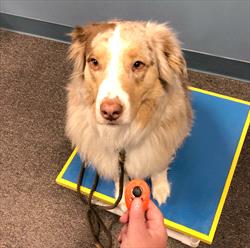A marker is a word, sound or gesture that signals the exact moment your pet has offered a behavior you like and want repeated.
Author holds a clicker.

Photo Courtesy of Pat Koven, LVT, KPA-CTP
A marker is a word, sound or gesture that signals the exact moment your pet has offered a behavior you like and want repeated. It is a language bridge between species and communicates to your pet they have earned a reinforcement for something they just did. A marker is a camera snapshot, marking the split second of an act. Marking and reinforcing that moment increases the likelihood of your pet repeating that desired behavior. The marker predicts the reinforcement is coming and is a promise of a paycheck. The reward always comes immediately after the marker.
A marker should be clear, concise, and consistent. It should be repeatable with minimal variation.
A verbal marker should be the same word each time and used by everyone involved in your pet’s training. The word “yes” is short and positive sounding and more easily repeated than “good girl” or “good boy”. Verbal markers carry tone however which can influence your dog’s response, making them hesitant if they perceive your bad mood.
Hand signals and gestures can be used as alternative markers for hearing-impaired animals, animals working at a far distance or underwater.
A clicker is most often used as an audible marker. It is a preferred marker by most trainers and comes in many styles. The sound produced is consistent regardless of who is using it, without inflection or conveying tone. It will make the identical sound regardless of who is using it. A clicker can mark subtle movements, making training precise.
Begin teaching the meaning of the marker by clicking, verbalizing, or gesturing then quickly giving the reinforcement. Repeat this five times. Then begin using the marker for training other behaviors.